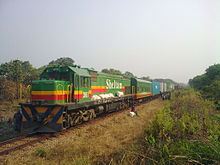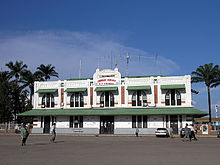Rail transport in the Democratic Republic of the Congo
The rail transport in the DRC takes place on a number of independent rail networks and different technical parameters, in particular different track gauges instead. If they are not integrated into a mining operation, they are of little economic importance today .
requirements
The main artery in the north of the Congo is the Congo River and its tributaries. However, this river system cannot be navigated continuously as it is impassable for ships in some places. One reason to build the first railways in the Congo was to bypass such sections. The south of today's Democratic Republic of the Congo, on the other hand, was opened up by rail from southern Africa, so that the railways being built there were based on the technical parameters introduced there. This included, among other things, the takeover of the Cape Track .
history
In the age of railroad construction, most of the area of today's Democratic Republic of the Congo was ruled by the Congo Free State , which was recognized by the Congo Conference in 1885. In fact, it was an economically oriented society chaired by King Leopold II of Belgium with the aim of exploiting the Congo economically. This was only possible in the medium term if railways were also available. In 1889, for example, the Compagnie du Chemin de Fer du Congo was founded in Brussels as the first railway company for the Congo . Up until the First World War , a number of societies were established that pursued the economic exploitation of the Congo, partly also through the construction of railways. It was not until 1908 that the Belgian state took over the area and formally established a colony, Belgian Congo . It was not until 1930 that the colony had its own railway authority, the Office d'exploitation des Transports Coloniaux (OTRACO). This took over the railway operations of a number of private companies in the course of the following years. After the country gained independence in 1960, the abbreviation remained, but has now been dissolved as the Office d'exploitation des Transports du Congo . Other large nationalized railway companies in the country were the Office Congolais des Chemins de fer du Grands Lacs (CFL), the Chemins de fer Kinshasa-Dilolo-Lubumbashi (KDL) and the Chemins de fer vicinaux du Zaire (CVZ) from 1966. 1971 became off the OTRACO the Office National des Transports (ONATRA). Finally, in 1974, all of these railway companies were merged to form the Société Nationale des Chemins de fer du Zaire (SNCZ). In 1991 this was transformed into a holding company for three regionally structured railway companies (South, East and Uele), from 1997: Société Nationale des Chemins de fer du Congo .
Today, the company is suffering from the extremely poor condition of the railway infrastructure: a train takes around 2 weeks to cover the 1500 km route from Lubumbashi to Kindu.
Northwest

The Matadi – Léopoldville railway was the first railway to be built from Matadi in 1892–1898 and opened in sections. It was carried out in 765 mm track and was 392 km long. In 1932 it was replaced by a partially re-routed route in the same relation, which was 372 km long, built in Cape Gauge and had been driven from Kinshasa since 1925. From 1899 to 1901 a route was led north from the then capital of the Congo Free State, Boma , initially to Lukula , and in 1925 extended to Tshéla . Between 1928 and 1938, this route was re-gauged to 600 mm in sections. Operations ceased in 1984.
Northeast
Starting from the Aketi , located on the Itimbri , a right tributary of the Congo, a network of routes with a gauge of 600 mm has been built in the northeast of the country since 1926:
- 1926–1927 Aketi – Libongo railway line , 121 km,
- 1931–1937 Railway (Aketi–) Komba Jonction – Mungbere , 686 km
- 1974 Aketi – Bumba railway line , 187 km
The routes also operated under the name Vicicongo .
See also: Uelle-Bahnen
In addition, the 125 km long Kisangani – Ubundu railway line in meter gauge was opened in the north-east of the country , running parallel to the Congo, in order to bypass parts of the river that were impassable for shipping.
Southern network
North-South Main Line
Components
The north-south main line through the province of Katanga (now also: Shaba) was created in 1952 through the connection of two separately operated rail projects: On the one hand, the railroad from Zambia (then: Rhodesia ) to Lubumbashi (then: Elisabethville) from southern Africa. and a railway line between Fungurume and Ilebo . The current kilometerage divides this main line into two railway lines: the Lubumbashi – Ilebo railway (1,578 km) and the Sakania – Lubumbashi railway (242 km).
History of the southern section
In 1910, the railway crossed the southern border of the Congo Free State when the railway line Livingstone – Sakania (812 km) was opened. It was designed in the Cape gauge common for main routes in southern Africa. The change of operation and the change of the kilometers between the Rhodesia & Katanga Junction Railway (RKJR) and the Compagnie de Chemin de fer de Katanga (CFK) connected here took place in Sakania , 11 kilometers in the interior of the Congo. From 1913/14 onwards, this line was driven 132 km from Lubumbashi / Elisabethville further north to Likasi , when further construction came to a halt due to the outbreak of the First World War . The construction of this south-north thoroughfare was only continued here after the Second World War . Badly damaged in the civil war, operations were closed in 1999, but resumed in 2005.
At the same time, a considerable number of connecting railways were built in connection with the main line, especially in the area around Likasi, to the numerous mining operations.
History of the northern section
Between Fungurume (today: km 208 from Lubumbashi / Elisabethville) and Bukama (today: km 454 from Lubumbashi / Elisabethville) a line was built between 1913 and 1918, which in 1926 went north to Kamina (today: km 600 km from Lubumbaschi / Elisabethville) ) and in 1927/28 further north in the direction of Léopoldville / Kinshasa to Ilebo (today: km 1578 from Lubumbashi / Elisabethville) on the Kasai , a left tributary of the Congo.
Gap closure
It was not until 1952 that the gap between Fungurume and Likasi was closed. The line was then straightened in some places by 1956 and electrified with 25,000 V single-phase alternating current 50 Hz . Today 858 km, according to other information 679 km, are under catenary .
A company founded in 1927, the Sociète de Chemin de fer Léopoldville – Katanga – Dilolo , had the goal of connecting the Katanga railway network with Léopoldville, which had been the capital since 1926. However, this gap has not yet been closed.
Connecting lines
1931 at the station Teneke the connection to the from Angola coming Benguela connected, a track with a length of 520 km on the area of Congo and then 1350 km on Angolan area to the port of Lobito on the Atlantic Ocean . In the Kolwezi area , a considerable number of connecting railways to the numerous mining operations were established.
In the 1950s, an 888 km long connecting line to Kindu was built from Kamina station , from which a 274 km long line branches off to Kalemie in Zabalo . It was put into operation in sections from 1954. In the section Kongolo- Kalemie it replaced a meter-gauge railway that had been built mainly in the years 1913–1915 (the section Kabalo- Kongolo was added in 1939) and has now been re-gauged.
Other island rail companies
Around 1926, an approximately 50 km long electrified rail network with a 600 mm gauge was put into operation between the Kilo gold mine and the Kasenyi port on Lake Albert . There was only freight traffic here. In 1966, the railway was expropriated by the state without compensation. It is not known when operations ceased.
The Djokupunda – Makumbi railway was put into operation around 1929. It was 97 km long and was built in a 600 mm track. It ran parallel to the Kasai River. It is not known when operations ceased.
From Kalundu on Lake Tanganyika , a 94 km long route in Kapspur to Kamanyola was opened in 1931 , which was closed again in 1958. It connected to the Kalundu port railway, which had been in operation since 1929. The destination of the route was Bukavu , which was never reached.
Other rail transport
Numerous mining companies had their own factory railways. There was a tram in Boma at the end of the 19th century. In Kinshasa there is currently a suburban railway that mainly uses the routes of the Matadi-Kinshasa railway.
literature
- Neil Robinson: World Rail Atlas and Historical Summary 7 = North, East and Central Africa . o. O. 2009, pp. 15-21 and Plates 42, 43, 47-50, 54-56. ISBN 978-954-92184-3-5
Web links
- NN: Dozens who crash in Congo train . In: National Union of Rail, Maritime & Transport Workers (RMT) - Bristol Branch v. November 29, 2005 (based on a report by Arnaud Zajtman from the BBC) ( Memento from December 3, 2013 in the Internet Archive )






